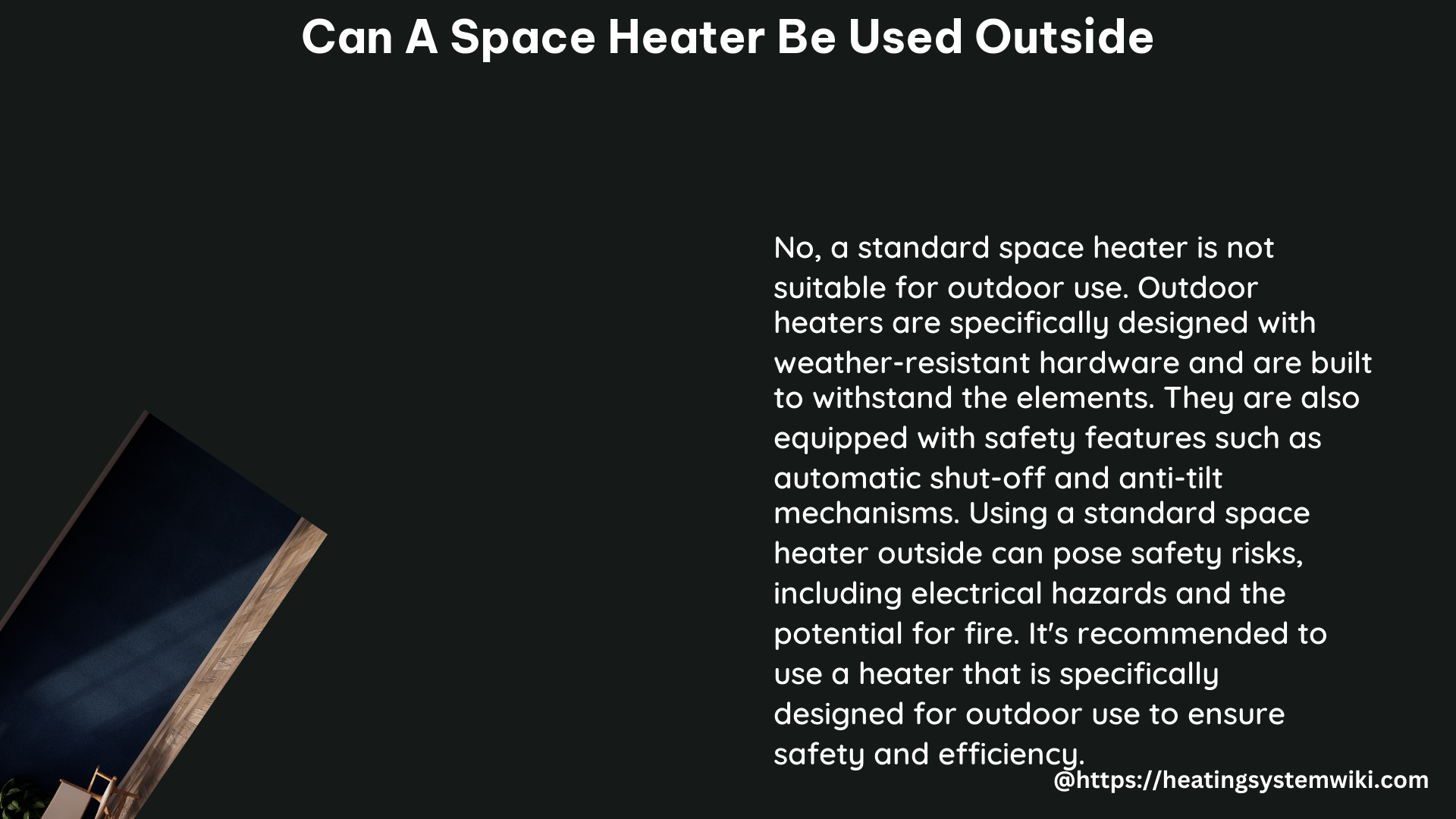Space heaters can be a convenient way to provide supplemental heat in outdoor areas, but it’s crucial to understand the safety considerations and technical specifications before using them outside. This comprehensive guide will delve into the factors to consider, the types of space heaters suitable for outdoor use, and a step-by-step DIY approach to ensure safe and effective outdoor heating.
Understanding the Risks of Outdoor Space Heater Use
Using a space heater outdoors presents unique challenges compared to indoor use. The primary concerns are:
-
Clearance and Ventilation: Space heaters require adequate clearance on all sides, including above, to prevent fire hazards and ensure proper airflow. Insufficient clearance can lead to overheating and potential ignition of nearby combustible materials.
-
Exposure to the Elements: Outdoor space heaters must be able to withstand exposure to rain, wind, and other weather conditions without compromising safety or functionality.
-
Carbon Monoxide Buildup: Certain types of space heaters, such as those that use propane or natural gas, can produce carbon monoxide, a colorless and odorless gas that can be deadly in enclosed or poorly ventilated spaces.
-
Electrical Safety: Electric space heaters should never be used in areas where they may come into contact with water or moisture, as this can lead to electric shocks or short circuits.
Types of Space Heaters Suitable for Outdoor Use

Not all space heaters are designed for outdoor use. It’s essential to carefully review the manufacturer’s instructions and specifications to ensure the heater is suitable for the intended outdoor application.
Propane Space Heaters
Propane space heaters are a popular choice for outdoor heating, as they are portable and can provide significant heat output. These heaters are typically designed to be used in well-ventilated areas, such as under a covered patio or porch. Key considerations for propane space heaters include:
- Heat Output: Propane space heaters can range from 10,000 BTU to 40,000 BTU or more, allowing you to choose the appropriate size for your outdoor space.
- Ventilation Requirements: Propane heaters must be used in areas with adequate airflow to prevent the buildup of carbon monoxide. Manufacturers typically recommend a minimum of 2 square feet of open space per 10,000 BTU of heat output.
- Clearance: Propane space heaters should be placed at least 3 feet away from any combustible materials, including walls, furniture, and overhead structures.
Electric Space Heaters
Electric space heaters can also be used outdoors, but they require special considerations to ensure safety. These heaters are generally not recommended for use in areas where they may come into contact with water or moisture, as this can lead to electric shocks or short circuits. If using an electric space heater outdoors, it’s essential to:
- Use Weatherproof Outlets: Ensure that any electrical outlets used for the space heater are properly grounded and protected from the elements.
- Maintain Clearance: Electric space heaters should be placed at least 3 feet away from any combustible materials, just like propane heaters.
- Consider Portable Options: Portable electric space heaters designed for outdoor use may be a safer option, as they can be easily moved and positioned as needed.
Tabletop and Patio Heaters
Tabletop and patio heaters are a specialized type of outdoor space heater that are designed to be used in covered outdoor areas, such as patios, porches, or gazebos. These heaters typically use propane or electricity as the heat source and are often equipped with features like wheels or stands to make them easy to move and position.
When using tabletop or patio heaters, it’s essential to:
- Ensure Proper Clearance: Maintain a minimum clearance of 3 feet from any combustible materials, including overhead structures.
- Provide Adequate Ventilation: Propane-powered patio heaters require well-ventilated areas to prevent carbon monoxide buildup.
- Secure the Heater: Ensure the heater is stable and won’t tip over, which could pose a fire hazard or cause injury.
DIY Outdoor Space Heater Safety Checklist
If you’re planning to use a space heater outdoors, follow these steps to ensure safe and effective operation:
-
Read the Manufacturer’s Instructions: Carefully review the owner’s manual to understand the heater’s specific safety requirements, heat output, and recommended usage guidelines.
-
Assess the Outdoor Space: Measure the area where you plan to use the space heater and ensure there is adequate clearance on all sides, including above. Refer to the manufacturer’s recommendations for the minimum clearance requirements.
-
Ensure Proper Ventilation: Determine if the outdoor space has sufficient airflow to prevent the buildup of carbon monoxide or other harmful fumes. For propane heaters, ensure the area has at least 2 square feet of open space per 10,000 BTU of heat output.
-
Secure the Heater: Place the space heater on a stable, level surface and secure it to prevent it from tipping over or being knocked down by wind or other environmental factors.
-
Protect from the Elements: If using an electric space heater, ensure that the power cord and any electrical connections are protected from moisture and weather conditions.
-
Monitor the Heater: Regularly check the space heater while in use to ensure it is functioning properly and that there are no signs of overheating or other safety concerns.
-
Have a Fire Extinguisher on Hand: Keep a fire extinguisher nearby in case of any emergencies.
By following these steps and adhering to the manufacturer’s instructions, you can safely and effectively use a space heater to provide supplemental heat in your outdoor living spaces.
Conclusion
Using a space heater outdoors requires careful consideration of safety factors, such as clearance, ventilation, and exposure to the elements. By understanding the specific requirements for outdoor space heater use and following a comprehensive safety checklist, you can enjoy the warmth and comfort of a space heater in your outdoor living areas while prioritizing the safety of your family and property.
